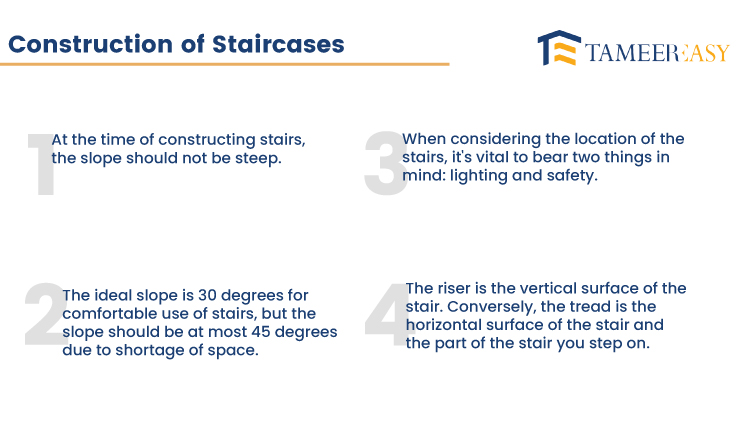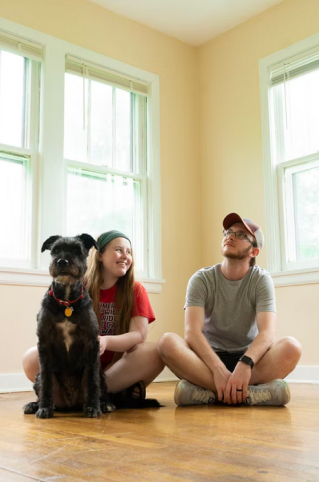The stairs, which make it simple to go from one floor to the next, are one of the most crucial components of any structure or home. You may have noticed that while certain stairs are easy to climb or descend, others can be difficult.
Visit TameerEasy Store to Purchase Quality Construction Items
What causes this to occur, and what are different aspects need to be taken into account when building stairs? What components are employed, and what crucial procedures are required to make them durable? All of these queries have answers in the article.

Stairs and Their Importance
The staircase is an arrangement of steps that makes it easier for people to go between two levels or floors by breaking the vertical distance into more manageable steps. Also known as stairs or a flight of stairs.
Features or Elements of Staircase
Step or Tread
The first and most crucial staircase component is the step or tread, the flat surface on which we set our feet to ascend or descend the Perfect stairs.
Riser
Secondly, there is a riser, a vertical element that connects two treads, and its height is always kept uniform to prevent tripping even if someone climbs or descends with closed eyes.
Important Dimensions
Depending on where the staircase is built, the riser can be between five and seven inches high, and the tread can be between ten and thirteen inches wide. The riser height is often around five inches to comfort patients or old people in hospitals, while the tread is fixed at thirteen inches.
Nosing, or the edge of the tread that extends beyond the riser, is another crucial component. On the margins of steps, we use marble or granite, this edge, known as the nosing, extends past the riser on one side.
A railing, often constructed of wood, iron, or aluminium, is on one or both sides of the perfect stairs. This handrail supports climbing up or down the stairs and is there for safety reasons. Vertical frameworks known as spindles or balustrades are installed underneath this railing. Additionally, they can run along one or both sides and have different shapes and materials.
The landing, made after every ten steps and has the same height as a tread or step but a width equivalent to three or four flights of stairs, is also built. This enables anyone going up or down to stop and rest for a moment.
Material Commonly Used in Stairs
Depending on the preferences of your architect and the site where the stairs will be built, staircases can be made of various designs and materials. In residential buildings, hospitals, recreational facilities, factories, and educational institutions, multiple stairs are built, each with a unique arrangement of risers and treads.
Since we’re talking about home building, most homes typically have hardwood staircases supported by mild steel (MS) frames. You can also build concrete stairs, which is a combination of perfect stairs and concrete.


Different Types of Stairs
Straight stairs, L-shaped stairs, U-shaped stairs, spiral stairs, curved stairs, winder stairs, cantilever stairs, space stairs, and bifurcation stairs are only a few of the different forms of stairs.
These are a few of the several stair styles, frequently utilised in different architectural designs.
1). Straight Stairs
Straight stairs are a continuous straight flight of steps without any curves or changes in direction.
2). L-Shaped Stairs
L-shaped stairs have one straight flight followed by a 90-degree curve to the left or right that ends at a landing.
3). U-Shaped Stairs
Additionally, a straight flight of perfect stairs in the shape of a U leads to a landing, and another flight begins in a different direction. It is a perfect case of U-Shaped stairs.
4). Spiral Staircases
Typically, spiral staircases have a helical shape around a central axis. Maintaining appropriate breadth for secure footing is critical because the tread width narrows towards the centre.
5). Curved Stairs
Curved stairs have a spiral-like appearance but are not completely round. They frequently feature a half- or quarter-circle form, which enhances their aesthetic appeal. Larger homes frequently have lounges with curved steps.
6). Winder Stairs
The Winder stairs have a straight staircase and a square landing with three sections. You can use this type in areas with little available space.
7). Cantilever Staircases
Cantilever staircases have one fixed end while the other half floats in the air. Space stairs is another name for them.
8). Bifurcation Stairs
Last but not least, some steps have a beam instead of a way slab beneath them, and bifurcation stairs branch out on either side.
These are a few of the several stair styles, frequently utilised in different architectural designs.
Stairs’ Types as per Usage
This comprises the major stairs, the main access points between the lobby entry and the upper floor. There is more movement and traffic on these stairs.
For emergency scenarios, we use fire-escape stairs. Especially in public parts of a building where they offer an exterior exit to guarantee that people may safely flee during crises.
Service stairs are used for practical purposes and are not frequently used. Hence their usage involves moving staff or service personnel from one floor to another.
These are a few stair types, used in architectural designs for particular purposes.
Final Thoughts
We hope you now clearly understand what stairs are and how they differ. Finally, if you still need help or have any queries about stairs, you can contact us anytime through our website, tameereasy.







